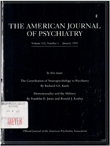Bereavement after homicide: a synergism of trauma and loss
Abstract
OBJECTIVE: The purpose of this study was to examine the intensity and relationship of trauma and responses to bereavement in family members after homicide. METHOD: The authors established an outpatient clinic that offered evaluation and supportive psychotherapy after the homicide of a family member. A standardized evaluation protocol was followed with 18 adults in order to detail variables of previous trauma, bereavement, and psychiatric disorder. Standardized measures of bereavement (Texas Revised Inventory of Grief) and trauma (Impact of Event Scale and Dissociative Experiences Scale) were also administered. RESULTS: As a group, the 18 adults were characterized by a high frequency of antecedent psychiatric disorder (N = 12), the homicide of a child (N = 12), and an intensely idealized attachment to the decreased, whose image of violent dying recurred as a disorganizing flashback and dream. The measures of bereavement and trauma showed generally higher levels of intensity in the 18 subjects in the present study than in normal subjects and other cohorts of bereaved subjects. CONCLUSIONS: For those who have lost a family member through homicide, recognition of a relatively specific pattern of dysfunctional responses of grief and trauma would promote early identification and psychiatric referral.
Access content
To read the fulltext, please use one of the options below to sign in or purchase access.- Personal login
- Institutional Login
- Sign in via OpenAthens
- Register for access
-
Please login/register if you wish to pair your device and check access availability.
Not a subscriber?
PsychiatryOnline subscription options offer access to the DSM-5 library, books, journals, CME, and patient resources. This all-in-one virtual library provides psychiatrists and mental health professionals with key resources for diagnosis, treatment, research, and professional development.
Need more help? PsychiatryOnline Customer Service may be reached by emailing [email protected] or by calling 800-368-5777 (in the U.S.) or 703-907-7322 (outside the U.S.).



